Fire Danger Assessment Using Moderate-Spatial Resolution Satellite Data
Abstract
1. Introduction
2. Methodology
2.1. Basic Approaches to Fire Danger Assessment
2.2. Methodology for Modifying the Fire Danger Index FWI
2.3. Application of Satellite and Geoinformation Data as Input to the Calculation of a Fire Danger Index
3. Results and Discussion
4. Conclusions
Supplementary Materials
Author Contributions
Funding
Institutional Review Board Statement
Informed Consent Statement
Data Availability Statement
Conflicts of Interest
References
- Shumilo, L.; Yailymov, B.; Shelestov, A. Active fire monitoring service for Ukraine based on satellite data. In Proceedings of the International Geoscience and Remote Sensing Symposium, Waikoloa, HI, USA, 26 September–2 October 2020; pp. 2913–2916. [Google Scholar] [CrossRef]
- Kussul, N.; Yailymov, B.; Shelestov, A.; Yailymova, H. Fire danger assessment based on the improved fire weather index. In Proceedings of the International Geoscience and Remote Sensing Symposium, Kuala Lumpur Convention Centre (KLCC), Kuala Lumpur, Malaysia, 17–22 July 2022; pp. 1584–1587. [Google Scholar] [CrossRef]
- Chuvieco, E.; Aguado, I.; Jurdao, S.; Pettinari, M.L.; Yebra, M.; Salas, J.; Hantson, S.; de la Riva, J.; Ibarra, P.; Rodrigues, M.; et al. Integrating geospatial information into fire risk assessment. Int. J. Wildland Fire 2014, 23, 606–619. [Google Scholar] [CrossRef]
- You, W.; Lin, L.; Wu, L.; Ji, Z.; Zhu, J.; Fan, Y.; He, D. Geographical information system-based forest fire risk assessment integrating national forest inventory data and analysis of its spatiotemporal variability. Ecol. Indic. 2017, 77, 176–184. [Google Scholar] [CrossRef]
- Canadian Forest Fire Danger Rating System (CFFDRS). Available online: https://cwfis.cfs.nrcan.gc.ca/background/summary/fdr (accessed on 5 December 2022).
- European Forest Fire Information System. Available online: http://effis.jrc.ec.europa.eu (accessed on 5 December 2022).
- FIRMS FAQ–Earthdata–NASA. Available online: https://www.earthdata.nasa.gov/faq/firms-faq (accessed on 5 December 2022).
- Canadian Forest Fire Behavior Prediction (FBP) System. Available online: https://cwfis.cfs.nrcan.gc.ca/background/summary/fbp (accessed on 5 December 2022).
- Beaudoin, A.; Bernier, P.Y.; Guindon, L.; Villemaire, P.; Guo, X.J.; Stinson, G.; Bergeron, T.; Magnussen, S.; Hall, R.J. Mapping attributes of Canada’s forests at moderate resolution through k NN and MODIS imagery. Can. J. For. Res. 2014, 44, 521–532. [Google Scholar] [CrossRef]
- Fire Danger (Canadian Fire Weather Index System) in the Global Wildfire Information System (version 2-3-1). European Commission, Joint Research Centre (JRC). [Dataset]. 2018. Available online: http://data.europa.eu/89h/4b4f1ea6-da7b-4870-9be4-aa5b9a2a4b70 (accessed on 5 December 2022).
- Canadian Forest Fire Weather Index (FWI) System. Available online: https://cwfis.cfs.nrcan.gc.ca/background/summary/fwi (accessed on 5 December 2022).
- Van Wagner, C.E. Development and Structure of the Canadian Forest Fire Weather Index System. Forestry Technical Report 35. Canadian Forest Service. 1987. Available online: https://cfs.nrcan.gc.ca/publications?id=19927 (accessed on 5 December 2022).
- Stocks, B.J.; Lawson, B.D.; Alexander, M.E.; Van Wagner, C.E.; McAlpine, R.S.; Lynham, T.J.; Dube, D.E. The Canadian Forest Fire Danger Rating System: An overview. For. Chron. 1989, 65, 450–457. [Google Scholar] [CrossRef]
- Dowdy, A.J.; Mills, G.A.; Finkele, K.; de Groot, W. Australian fire Weather as Represented by the McArthur Forest Fire Danger Index and the Canadian Forest Fire Weather Index; Technical Report No. 010; CAWCR: Melbourne, Australia, 2009. Available online: http://www.cawcr.gov.au/technical-reports/CTR_010.pdf (accessed on 5 December 2022).
- Kussul, N. Information Technology for Fire Danger Assessment and Fire Monitoring in Natural Ecosystems Based on Satellite Data (Competition of the National Research Foundation of Ukraine “Science for Human Security and Society”): Interim Research Report; (SR No 0120U104886); Space Research Institute NAS of Ukraine and SSA of Ukraine: Kyiv, Ukraine, 2021; 155p. (In Ukrainian)
- Pidgorodetska, L.; Zyelyk, Y.; Kolos, L.; Fedorov, O. Surface soil moisture deficit assessment based on satellite data. In Proceedings of the XIXth International Conference “Geoinformatics: Theoretical and Applied Aspects”, Kyiv, Ukraine, 11–14 May 2021; pp. 1–6. [Google Scholar] [CrossRef]
- Kussul, N.; Lavreniuk, N.; Shelestov, A.; Yailymov, B.; Butko, I. Land Cover Changes Analysis Based on Deep Machine Learning Technique. J. Autom. Inf. Sci. 2016, 48, 42–54. [Google Scholar] [CrossRef]
- ERA5-Land Hourly Data from 1981 to Present. Available online: http://cds.climate.copernicus.eu/cdsapp#!/dataset/reanalysis-era5-land?tab=overview (accessed on 5 December 2022).
- Tóth, B.; Weynants, M.; Pásztor, L.; Hengl, T. 3D soil hydraulic database of Europe at 250 m resolution. Hydrol. Process. 2017, 31, 2662–2666. [Google Scholar] [CrossRef]
- Panagos, P.; Van Liedekerke, M.; Jones, A.; Montanarella, L. European Soil Data Centre: Response to European policy support and public data requirements. Land Use Policy 2012, 29, 329–338. [Google Scholar] [CrossRef]
- European Soil Data Centre (ESDAC). Available online: http://esdac.jrc.ec.europa.eu (accessed on 5 December 2022).
- Bosilovich, M.G.; Lucchesi, R.; Suarez, M. MERRA-2: File Specification; GMAO Office Note No. 9 (Version 1.1); 2016; 73p. Available online: http://gmao.gsfc.nasa.gov/pubs/docs/Bosilovich785.pdf (accessed on 5 December 2022).
- Bauer-Marschallinger, B.; Paulik, C. Surface Soil Moisture Collection 1 km Version 1. Product User Manual. Issue I1.30. 2019. Available online: http://land.copernicus.eu/global/sites/cgls.vito.be/files/products/CGLOPS1_PUM_SSM1km-V1_I1.30.pdf (accessed on 5 December 2022).
- Shelestov, A.; Lavreniuk, M.; Kussul, N.; Novikov, A.; Skakun, S. Large scale crop classification using Google Earth Engine platform. In Proceedings of the International Geoscience and Remote Sensing Symposium, Fort Worth, TX, USA, 23–28 July 2017; pp. 3696–3699. [Google Scholar] [CrossRef]
- Olofsson, P.; Foody, G.M.; Stehman, S.V.; Woodcock, C.E. Making better use of accuracy data in land change studies: Estimating accuracy and area and quantifying uncertainty using stratified estimation. Remote Sens. Environ. 2013, 129, 122–131. [Google Scholar] [CrossRef]
- The State Emergency Service of Ukraine. Available online: http://www.dsns.gov.ua/ (accessed on 5 December 2022).
- Hall, J.; Zibtsev, S.; Giglio, L.; Skakun, S.; Myroniuk, V.; Zhuravel, O.; Goldammer, J.; Kussul, N. Environmental and political implications of underestimated cropland burning in Ukraine. Environ. Res. Lett. 2021, 16, 064019. [Google Scholar] [CrossRef] [PubMed]
- Kostyakov, A.N. Melioration fundamentals; Selkhozgiz: Moskow, Russia, 1960; 622p. (In Russian) [Google Scholar]
- Vlasova, O.V.; Samoilenko, L.I.; Pidhorodets’ka, L.V.; Kolos, L.M. Corn moisture deficit according to earth remote sensing data. Land Reclam. Water Manag. 2009, 96, 58–64. (In Ukrainian) [Google Scholar]
- Campbell, G.S.; Campbell, C.S. Water Content and Potential, Measurement. In Encyclopedia of Soils in the Environment; Hillel, D., Ed.; Elsevier: Amsterdam, The Netherlands, 2005; pp. 253–257. [Google Scholar] [CrossRef]
- Hengl, T.; de Jesus, J.M.; Heuvelink, G.B.M.; Gonzalez, M.R.; Kilibarda, M.; Blagotić, A.; Shangguan, W.; Wright, M.N.; Geng, X.; Bauer-Marschallinger, B.; et al. SoilGrids250m: Global Gridded Soil Information Based on Machine Learning. PLoS ONE 2017, 21, e0169748. [Google Scholar] [CrossRef]
- Zadorozhny, Y.V.; Smirnova, I.V. Methodical Recommendations for the Implementation of Practical Exercises. In Agricultural Melioration; Mykolaiv National Agrarian University: Mykolaiv, Ukraine, 2018; 149p, Available online: http://dspace.mnau.edu.ua/jspui/bitstream/123456789/4355/1/Silskohospodarska%20melioratsiia.pdf (accessed on 5 December 2022). (In Ukrainian)
- Volkov, V.N.; Narimanyants, E.V. Composition, Physical and Chemical Properties of Soils: Educational Guide. 2007. 48p. Available online: http://window.edu.ru/resource/887/68887/files/rsu664.pdf (accessed on 5 December 2022). (In Russian).
- Keetch, J.J.; Byram, G.M. A Drought Index for Forest fire Control; Res. Paper SE-38; U.S. Department of Agriculture Forest Service, Southeastern Forest Experiment Station: Asheville, NC, USA, 1968; 32p. [Google Scholar]
- Keetch–Byram Drought Index. Available online: http://en.wikipedia.org/wiki/Keetch%E2%80%93Byram_drought_index (accessed on 5 December 2022).
- Garcia-Pratsa, A.; Del Campo, A.; Tarcísio Fernandes, J.G.; Antonio Molina, J. Development of a Keetch and Byram-Based drought index sensitive to forest management in Mediterranean conditions. Agric. For. Meteorol. 2015, 205, 40–50. [Google Scholar] [CrossRef]
- Burgan, R.E. A method to initialize the Keetch–Byram drought index. West. J. Appl. For. 1993, 8, 109–115. [Google Scholar] [CrossRef]
- National Fire Danger Rating System. Available online: http://www.fs.usda.gov/detail/cibola/landmanagement/resourcemanagement/?cid=stelprdb5368839 (accessed on 5 December 2022).
- Ayvazyan, S.; Mkhitaryan, V. Applied Statistics and Econometrics: In 2 vol. Vol. 1: Probability Theory and Applied Statistics; Unity: Moscow, Russia, 2001; 656p. (In Russian) [Google Scholar]
- Ayvazyan, S.A. To methodology of population life quality synthetic categories measurement. Econ. Math. Methods 2003, 39, 33–53. (In Russian) [Google Scholar]
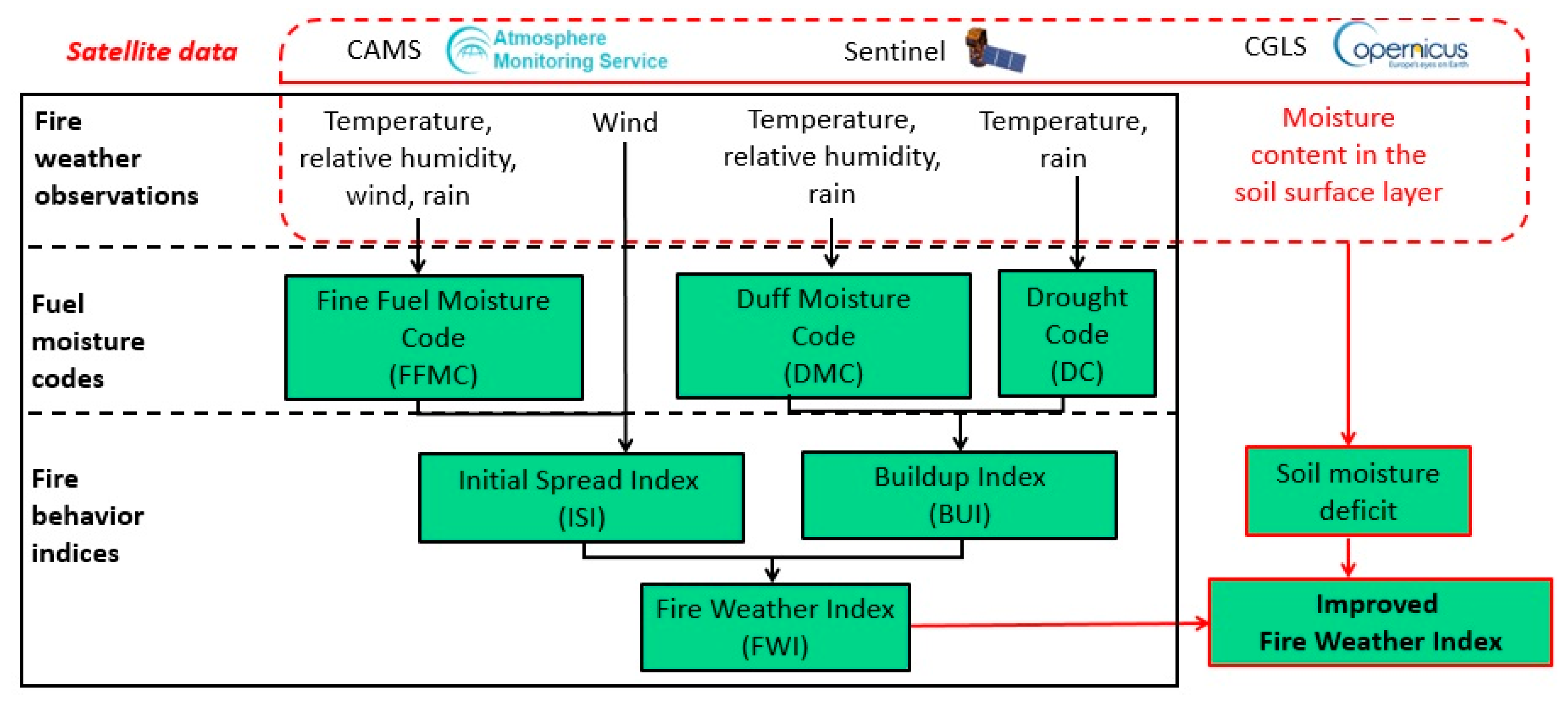
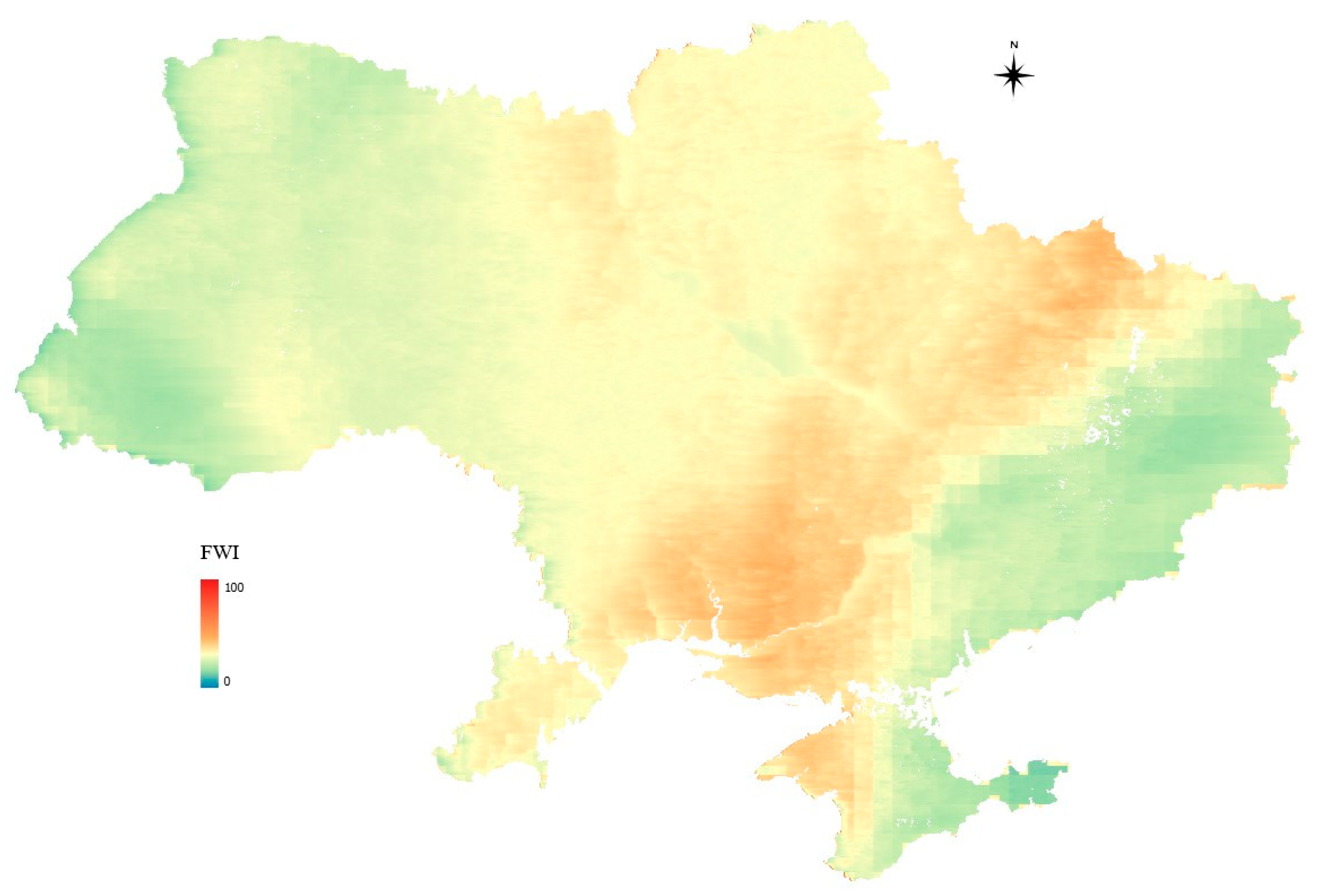
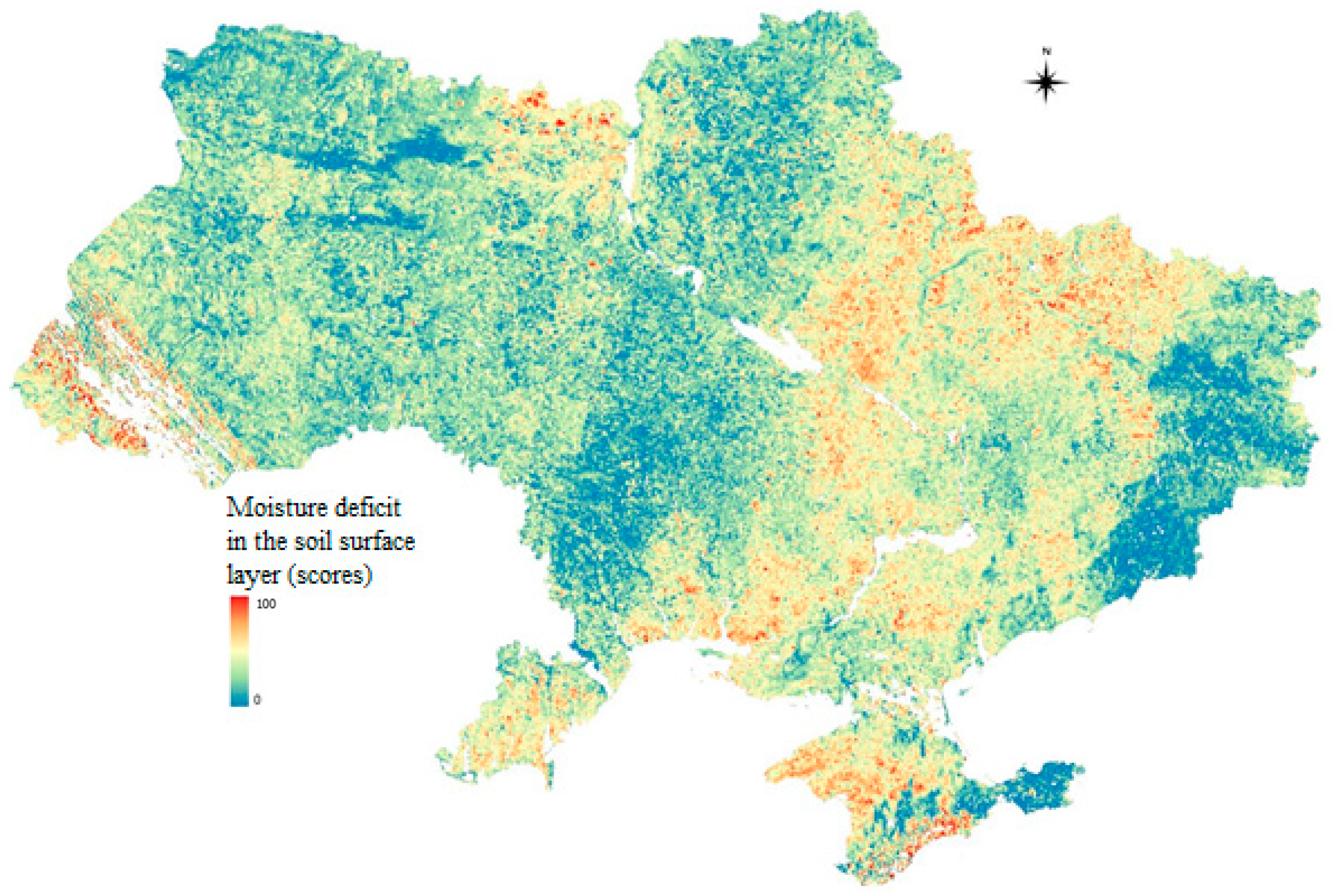
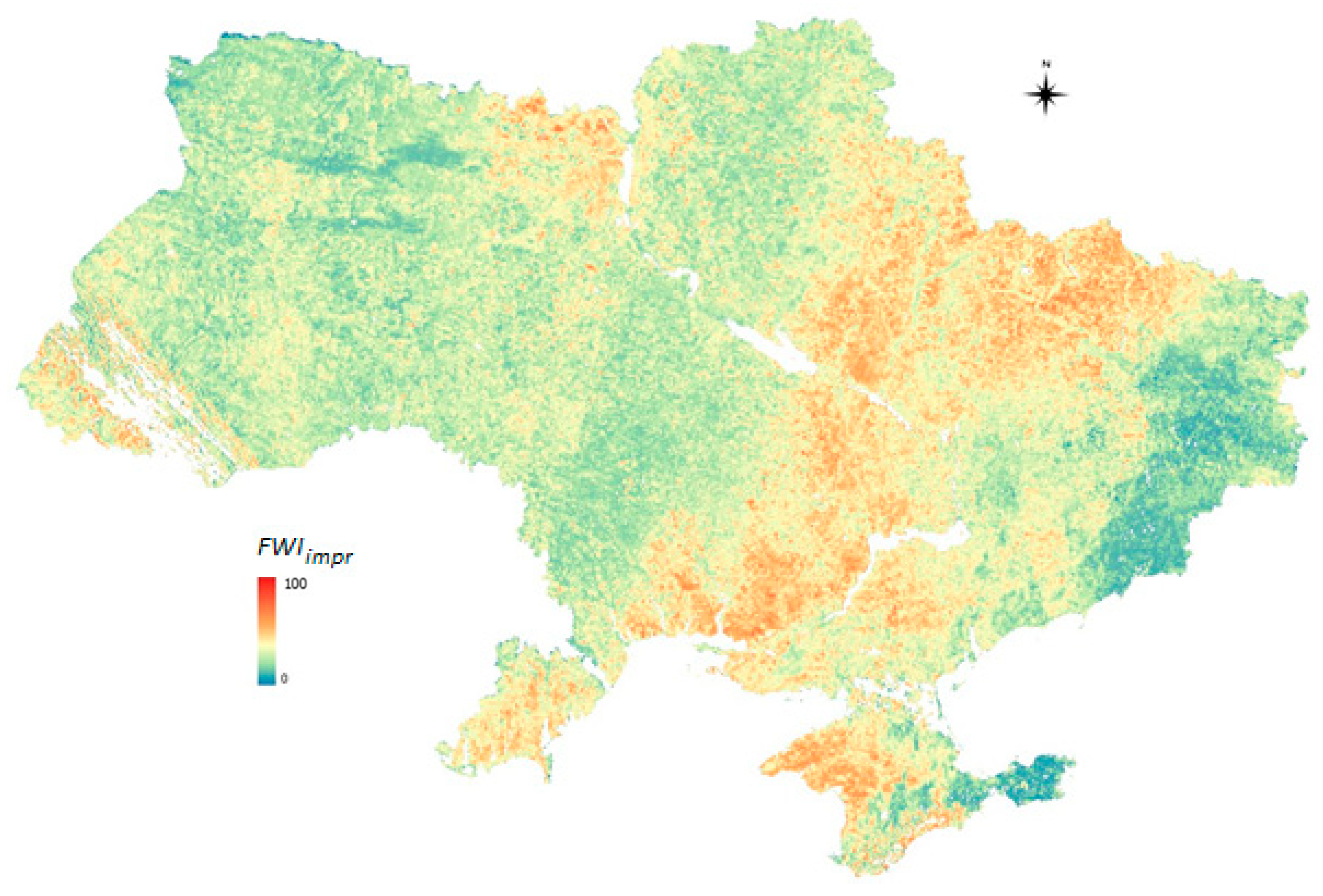
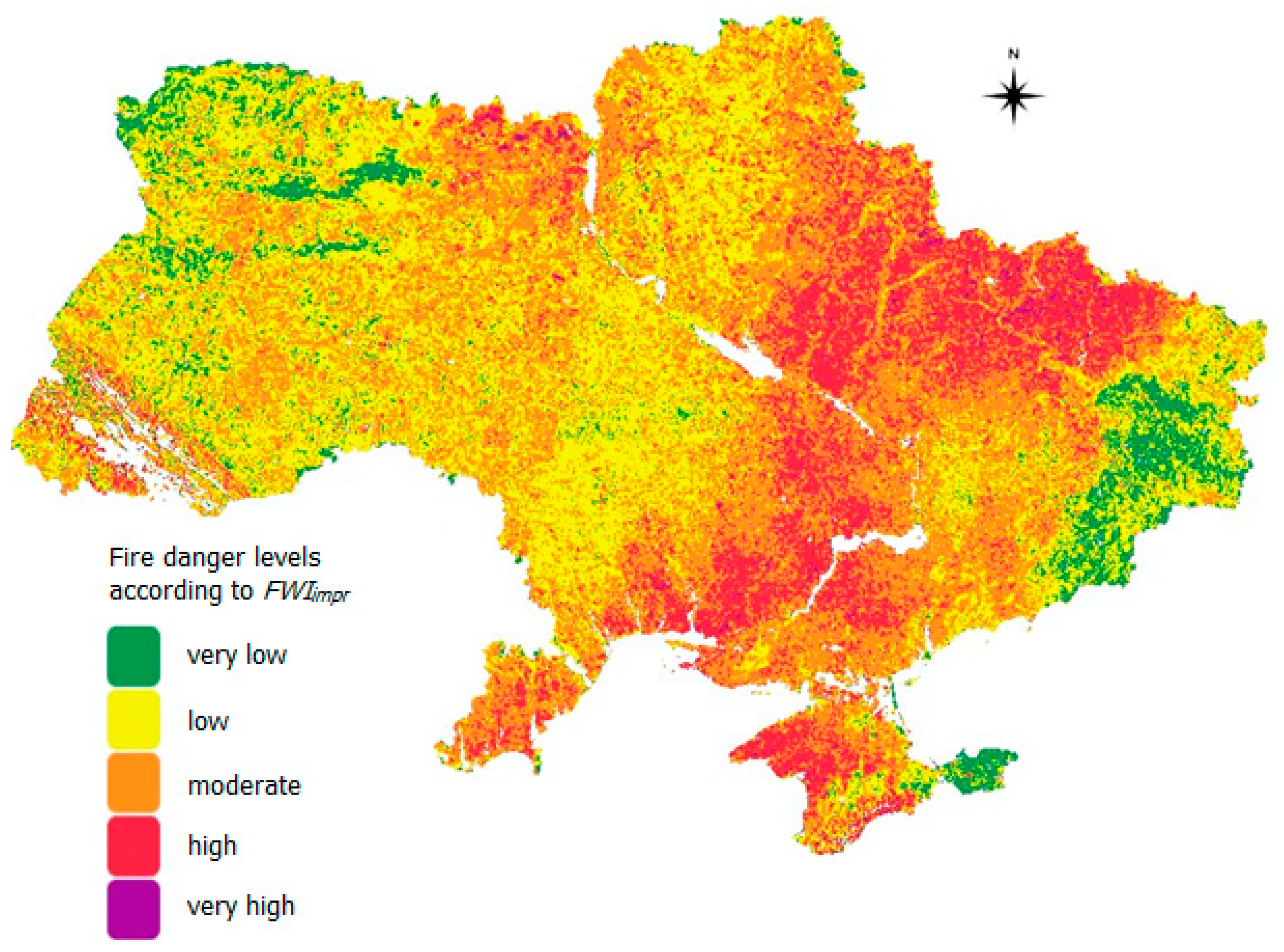
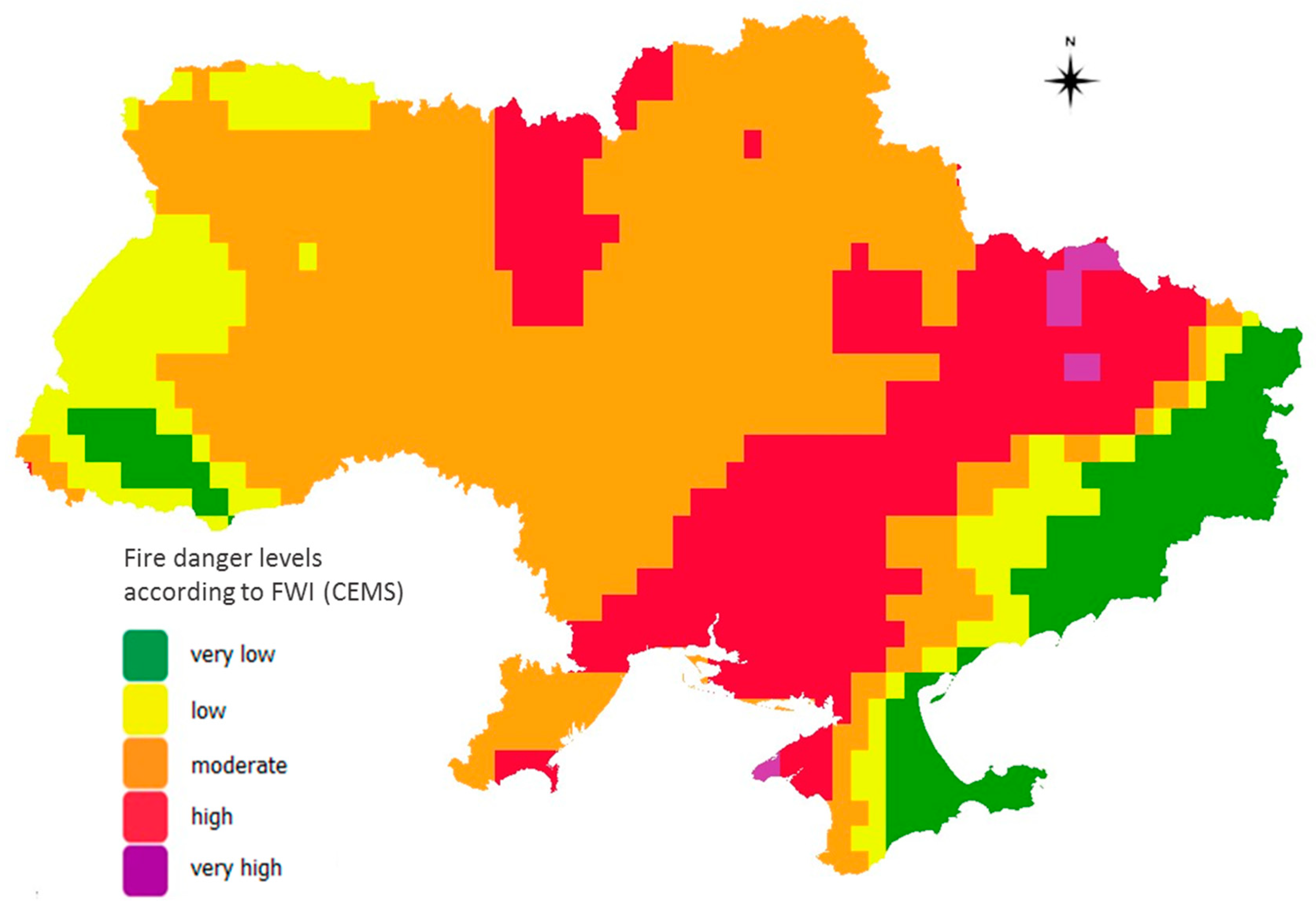
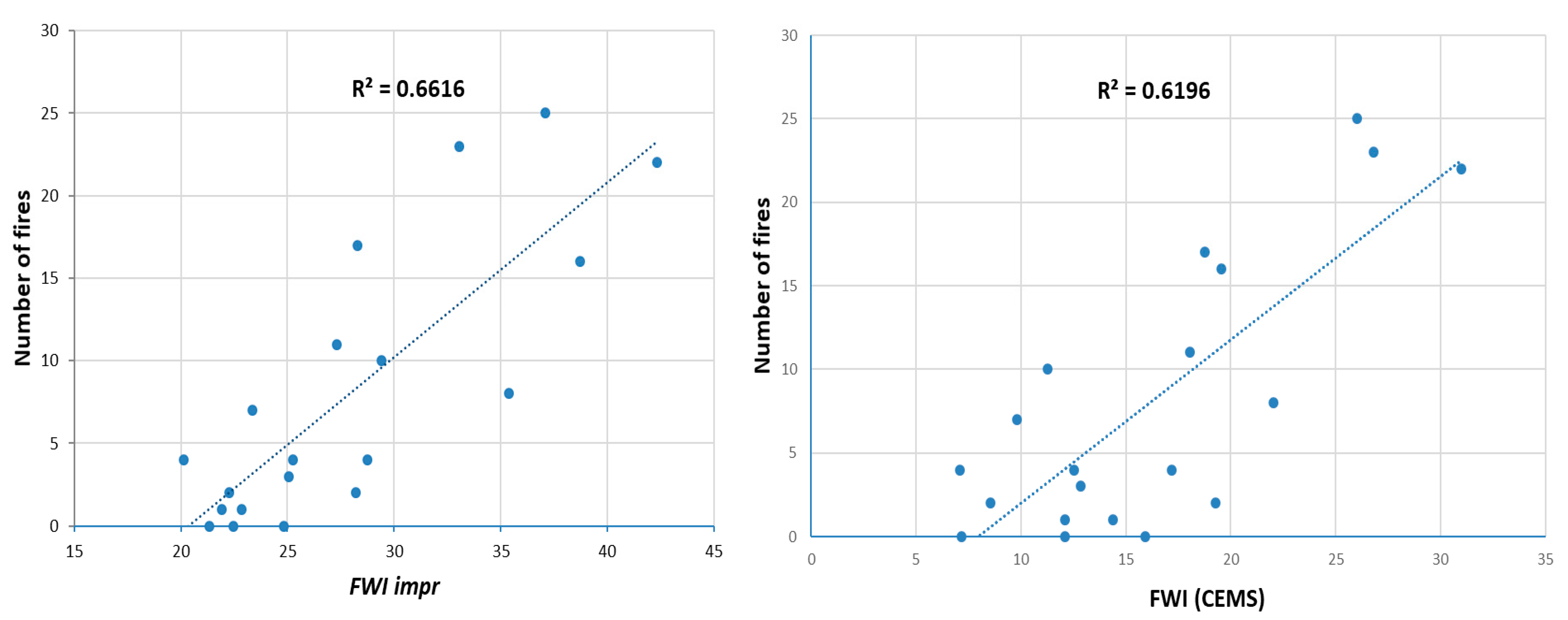
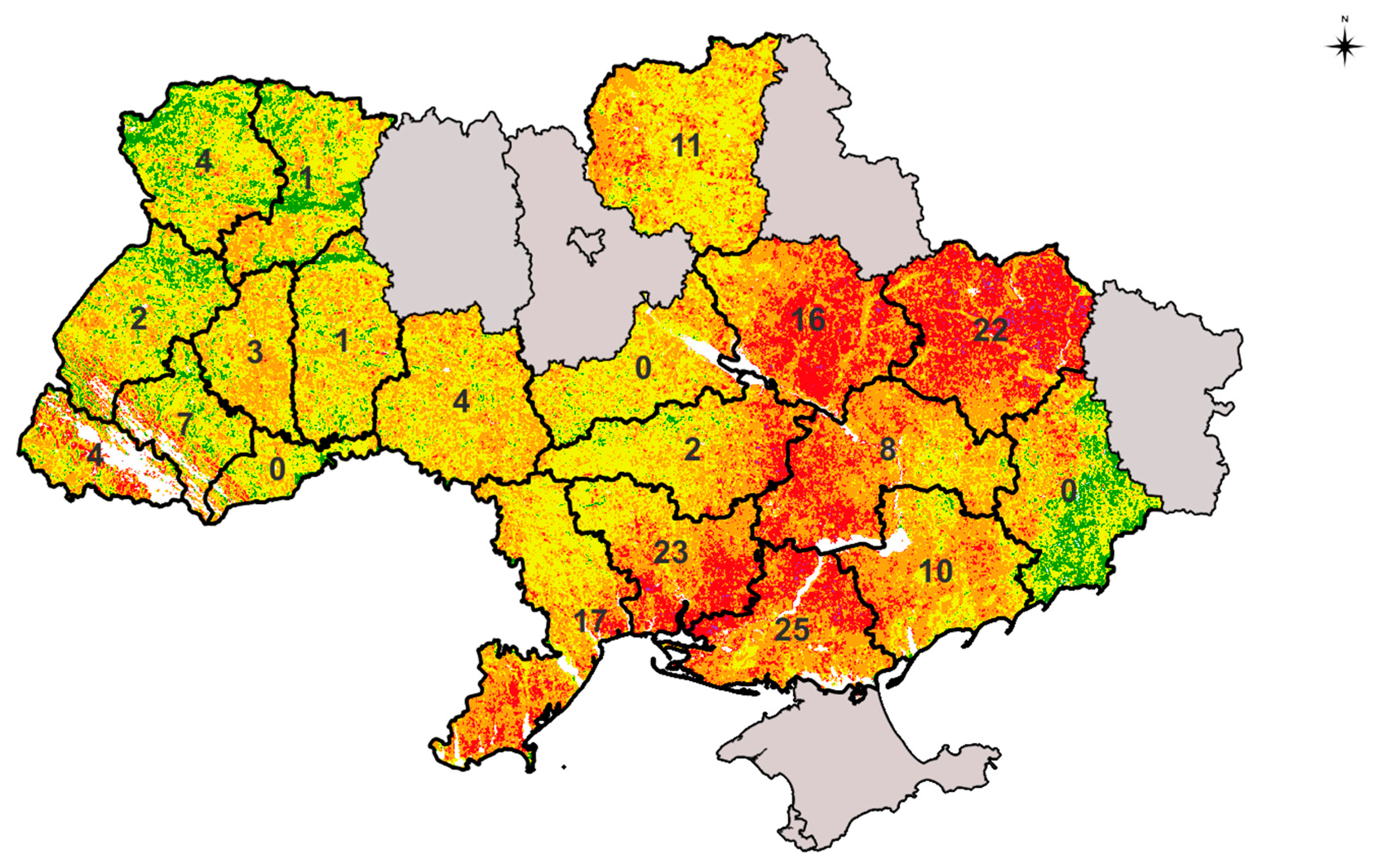
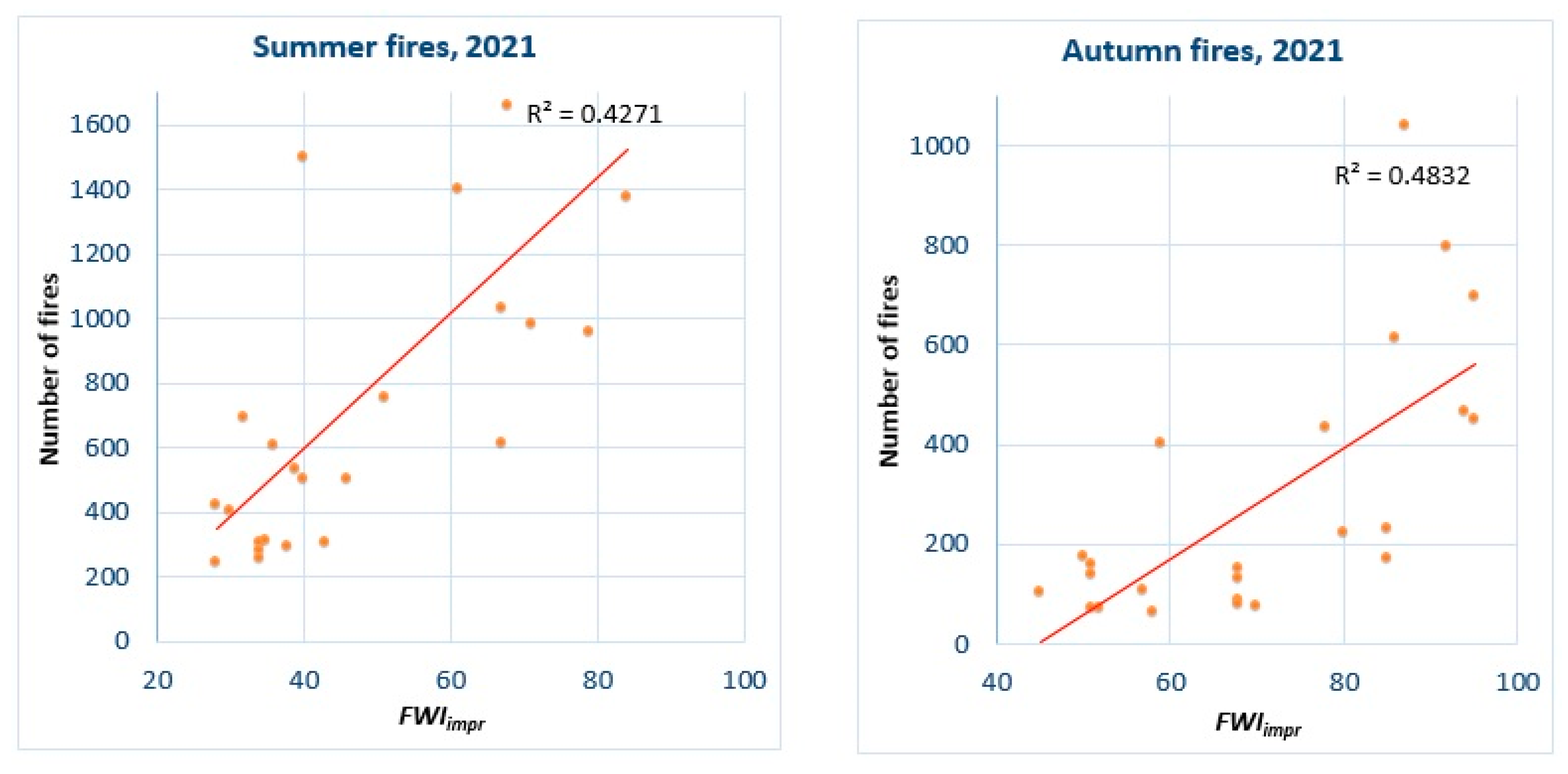
Disclaimer/Publisher’s Note: The statements, opinions and data contained in all publications are solely those of the individual author(s) and contributor(s) and not of MDPI and/or the editor(s). MDPI and/or the editor(s) disclaim responsibility for any injury to people or property resulting from any ideas, methods, instructions or products referred to in the content. |
© 2023 by the authors. Licensee MDPI, Basel, Switzerland. This article is an open access article distributed under the terms and conditions of the Creative Commons Attribution (CC BY) license (https://creativecommons.org/licenses/by/4.0/).
Share and Cite
Kussul, N.; Fedorov, O.; Yailymov, B.; Pidgorodetska, L.; Kolos, L.; Yailymova, H.; Shelestov, A. Fire Danger Assessment Using Moderate-Spatial Resolution Satellite Data. Fire 2023, 6, 72. https://doi.org/10.3390/fire6020072
Kussul N, Fedorov O, Yailymov B, Pidgorodetska L, Kolos L, Yailymova H, Shelestov A. Fire Danger Assessment Using Moderate-Spatial Resolution Satellite Data. Fire. 2023; 6(2):72. https://doi.org/10.3390/fire6020072
Chicago/Turabian StyleKussul, Nataliia, Oleh Fedorov, Bohdan Yailymov, Liudmyla Pidgorodetska, Liudmyla Kolos, Hanna Yailymova, and Andrii Shelestov. 2023. "Fire Danger Assessment Using Moderate-Spatial Resolution Satellite Data" Fire 6, no. 2: 72. https://doi.org/10.3390/fire6020072
APA StyleKussul, N., Fedorov, O., Yailymov, B., Pidgorodetska, L., Kolos, L., Yailymova, H., & Shelestov, A. (2023). Fire Danger Assessment Using Moderate-Spatial Resolution Satellite Data. Fire, 6(2), 72. https://doi.org/10.3390/fire6020072





